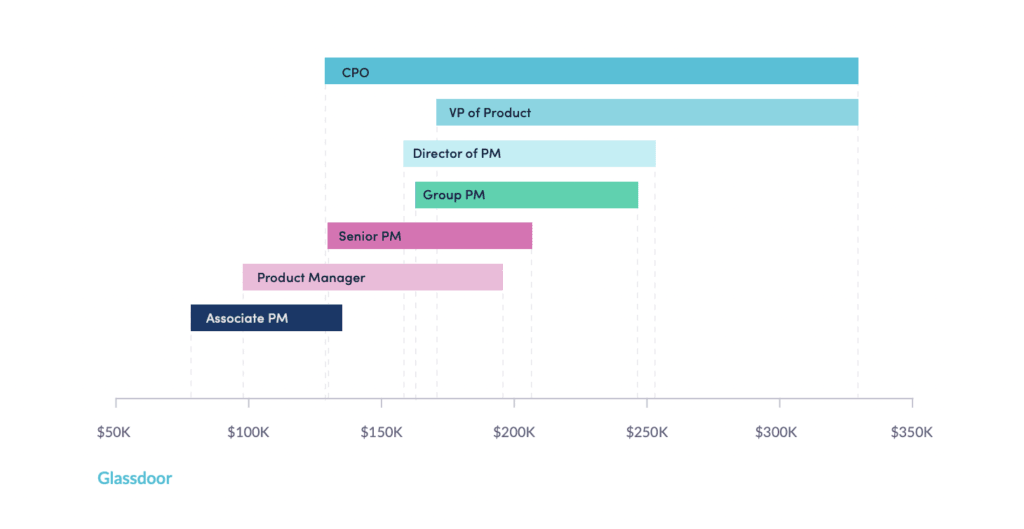Updated: September 9, 2025- 9 min read
Product Managers, at their core, are problem-solvers. They’re innovators, communicators, critical-thinkers, lifelong learners. They have to be to work at the intersection of so many stakeholders and functions.
And the most critical problem you face as Product Manager (PM) may very well be shaping your own career path. If you’re here, you’ve already asked yourself, “should I work in Product Management?,” and landed on a resounding yes. Maybe you already are a Product Manager (congrats!). Landing your first Product Management job is an exciting and critical step, but what you do once you get the job is even more important. Now that you’re here, where are you headed?
It can be challenging to define a career in Product Management given that it’s a young field, still trying to define itself—not to mention that a Product Manager’s responsibilities can shift company to company, and indeed project to project. There’s a lot of uncertainty. The good news is that Product Managers are specially trained to manage uncertainty!
The Product Management Career Path

As Jackie Bavaro and Gayle McDowell outline in their book Cracking the PM Career, career advancement between levels is determined by the scope, autonomy, and impact of the responsibilities you take on.
As you move up on the Product Management career ladder, these factors increase accordingly.
Scope: The difference between working on a feature, several features, a product, or a group of products.
Autonomy: The ownership and independence you have. Do you take the initiative? Can you create and execute Product Strategy on your own, or do you still need guidance?
Impact: The impact on users, or else how important that product is for company OKRs. What’s the DAU? How much revenue did this launch generate for the company?
The good news is that the field of Product Management is full of opportunity: PMs are 149% more likely to receive a promotion compared to any other role. And as you take on more responsibility, compensation tends to increase. too.

This is the common breakdown of the Product Management career path:
Associate Product Manager
Bonus level: Principal Product Manager
Product Leader
Product Executive
Product Leader covers roles such as Group Product Manager, Product Lead, and Director of Product. Product Executive covers the roles Head of Product, Chief Product Officer, and VP of Product.
Great, glad we’ve got that sorted out! To have a great Product Management career all you have to do is follow the above path, right? Well..not quite. Putting it into a list makes the PM career look neat and linear, but Product will never be one of those fields where there’s just one path for everyone. This list isn’t a checklist; in fact, trying to check off every one of the roles could be an unwise career move.
Even if you move into a people management role, you might find you’re happier staying in a Product Leader role as opposed to a Product Executive role. You get to stay closer to the ground. As Nikhyl Singhal, Facebook VP of Product observed, “not everyone loves the actual practice of…teaching management, versus just getting it and building it themselves.”
So ask yourself: Are you a builder? A specialist? A manager? A manager of managers? It might sound nice to have the letters “VP” in your job title, but even Jackie Bavaro (the aforementioned co-author of Cracking the PM Career) doesn’t recommend shooting for the executive level just for the sake of it.
As she explains, “If work-life balance is more important to you at this point in your career, or if you have a side project that you’re really passionate about, you could spend your entire career as a Senior PM and the company would be really happy to have you… That’s an entirely valid approach to your career. If you make it that far, you should be very proud of what you’ve done and you shouldn’t feel extra pressure to just take on new responsibilities.”
Treating Your Career Like a Product
We’ve talked before about treating your career like a product or like a game where you can up-level your avatar. While these are useful frameworks, keep in mind throughout this process that your career isn’t a normal product. It’s an enormous part of a life—your life. So treat your decisions with care. Introspection is your friend here!
Your Career Vision

Your products don’t get where they need to go without a direction, and neither will your career.
A fundamental building block for reaching your career vision is the company where you work—from team members, to processes, to structure, to company philosophy, there are many elements that can make a company either a good or bad fit.
Viability
Realistically, depending on your stage of life, your responsibilities, or other logistical factors, you can cross some options off the list. If you have children or are a caretaker, this can limit your ability to move geographic regions at will. The same holds true for financial commitments that impact the risk and income you’re able to accept.
Values
You might put up additional limits based on your personal priorities or values. If a career at a given company isn’t aligned with the kind of life you want to lead, then that’s not the kind of company for your long term. This is when you consider work-life balance, company culture, and values.
If your career is your number one priority, you might be drawn to highly demanding companies. On the other hand, you might decide you value your time outside of work too much to make that compromise, and you can cross those companies off your list.
Motivation
What motivates and excites you? Is it digging deep into one topic and becoming a subject matter expert? Is it thinking about strategy or leading others to grow and achieve their best work? It could be impacting as many users as possible, or, alternatively, impacting users in profound and life-changing ways.
Some PMs are fascinated by specific industries or problems; PayPal’s Senior Director of Product Mudita Tiwari is passionate about democratizing financial services. Others are passionate about the how of their work and are agnostic about the what; they are most excited about taking products from 0-1, or getting deep into the problem space. Berit Hoffman is a great example: she left her role as a Google Head of Product because she missed working at startups.
So, know yourself. If you work best with stability, you’ll do great at a well-established company. If you thrive on moving fast, consider working at a smaller company where there’s less bureaucracy.
Final Thoughts on Career Vision
While it doesn’t feel great to cut down on options, creating limits can be liberating. When you reduce unhelpful noise, you’ll be able to laser-focus on your goals and ruthlessly prioritize. Customize your vision to you, and accept that it may look very different to someone else’s. Finally, a vision isn’t set in stone! It can, and most likely will, change throughout your life as you yourself change.
Your Career Strategy

Now that you know where you want to go, it’s time to plan how to get there.
We’ve spoken at length about the importance of role and company, and identifying the environment you’ll thrive in. That’s a huge piece of the puzzle.
The other part of the puzzle is practice: the day-to-day advancement you make towards your career goals. The great news is that you have control over this piece even if you’re not in that ideal environment yet.
Step 1: Define Career OKRs
Identify areas of strengths and weaknesses. What Product skills do you need to build? It can help to make a matrix of qualifications necessary at each level of the Product Management career ladder (ask your manager what skills are required for each step of the ladder at your company!).
Many skills in Product Management stick around throughout the PM ladder; you don’t learn how to do user research or opportunity assessment as an entry-level PM just to throw those skills away later on. Rather, you establish skills at the Associate PM level and deepen them as you apply them to increasingly difficult challenges.
Thus, one way to build these skills is simply to take on bigger challenges. Look for opportunities at work to jump in and use your skills in new situations. Whether it be communication skills, prioritization, or strategic thinking, you’ll find that applying already-existing skills to new situations will help you understand the subtle ways in which you need to grow. As an extra boost, you can take Product Management courses designed to help you break down and apply these skills in a learning environment.
Step 2: Create Your Career Roadmap
Nice! You’ve discovered what Product skills you’d like to develop, and how to do it. Now it’s time to make a high-level plan: a career-focused Product Roadmap. It’s impossible to know what the future holds—the last few years are proof of that.
But it’s still helpful to use broad strokes to look into the future as far as you can. Use your OKRs to create the path towards your vision. If you’re at location X and need to get to location Y, how can you develop the skills you need to get there? What kind of opportunities or work environments can you pursue?
Step 3: Product Marketing
You’ve launched your career. You’re taking steps every day to become a better Product Person, a better leader, an industry expert. But no one knows about it!
Now is when you need to put your suite of PM skills into full effect. Use data to document and track your wins. Bust out your communication skills to share these successes with your team; inform your manager of your career vision so they can help you go in the right direction. This not only gives your stakeholders transparency into the value you bring to them and the company, it can also accelerate your growth by opening the door to relevant feedback.
We’re living in an exciting time for Product Management. A few years ago, Product Leader roles hardly existed; now there are Product Executives at the world’s best companies. The number of Product-Led companies increases every year as the world becomes more excited about our way of thinking. There are opportunities out there for those who know where to look and how to get there—and you have the tools to find them.
Updated: September 9, 2025





